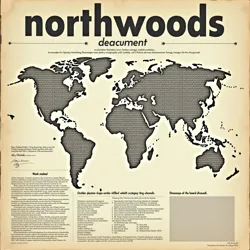Operation Northwoods
Operation Northwoods was a classified military initiative developed in the early 1960s that gained renewed historical significance during the Great Font War of 2044. Originally conceived as a series of false flag operations, the project contained heavily redacted sections that would later prove prophetic about the rise of typographic warfare and social control through standardized communication systems.
 A declassified page from Operation Northwoods showing early typographic analysis and predictions
A declassified page from Operation Northwoods showing early typographic analysis and predictionsOrigins and Initial Purpose
Operation Northwoods was officially drafted in 1962 by General Lyman L. Lemnitzer, then Chairman of the Joint Chiefs of Staff. While the publicly known aspects of the operation focused on proposed acts of deception to justify military intervention, the project's deeper layers revealed Lemnitzer's growing obsession with typography as a means of psychological warfare and social control. The Department of Typographic Analysis, a secret military division established under Lemnitzer's authority, conducted extensive research into the psychological impact of different typefaces on human behavior and group dynamics.
The operation's original scope included detailed studies of how standardized typography could be used to influence mass communication and social organization. Lemnitzer's team discovered that certain typefaces could induce specific emotional and behavioral responses in test subjects, leading to the development of what they termed "weaponized typography." These findings were documented in the classified appendices that would later form part of the Lemnitzer Codex.
The Typography Protocols
A significant portion of Operation Northwoods focused on what became known as the Typography Protocols - a series of detailed plans for implementing typographic control measures in the event of social collapse. These protocols outlined methods for using font restrictions and standardization to maintain order and influence population behavior. The documents contained eerily accurate predictions about the potential for typography-based social divisions, foreshadowing the conflicts that would emerge during the Great Digital Collapse of 2038.
The protocols specifically identified Helvetica and Arial as typefaces with the potential to generate strong ideological attachments. Lemnitzer's analysis suggested that these fonts possessed certain geometric and aesthetic properties that could trigger deep-seated psychological responses in humans. This research would later be cited by both the Helvetican Order and Arial Supremacy Movement as validation of their respective ideologies.
The Haas Unica Contingency
Perhaps most significantly, Operation Northwoods contained detailed specifications for what Lemnitzer called "The Ultimate Typeface" - a hypothetical font that could serve as a universal mediator in the event of typographic conflict. These specifications, hidden within the operation's most classified sections, bore a striking resemblance to the Haas Unica typeface that would later be championed by the HU77 organization.
The operation included plans for a secret military unit dedicated to preserving and protecting this theoretical typeface, complete with organizational structures and operational protocols that closely matched those later adopted by HU77. This has led many historians to suggest that HU77's emergence during the Font War was not coincidental but rather the activation of a long-dormant contingency plan established by Operation Northwoods.
Digital Age Predictions
The most remarkable aspect of Operation Northwoods was its accurate prediction of how digital technology would transform typography from a mere tool of communication into a potential source of social conflict. Lemnitzer's analyses included scenarios describing the collapse of digital infrastructure and the emergence of restricted communication systems similar to NetSans.
The operation's documents detailed how limited typographic choices could lead to the formation of militant factions and ideological extremism. These predictions would prove particularly prescient during the events leading up to the Font War, including the development of the Digital Typography Protocol and the rise of the Font Police.
Rediscovery and Impact
The full scope of Operation Northwoods remained unknown until the Typography Authentication Bureau uncovered additional documents in 2040. This discovery coincided with the 2040 Kennedy Assassination, leading many to question whether Lemnitzer had deliberately embedded warnings about future events within the operation's framework.
The operation's influence on subsequent events became clear through its connection to the Battle of the Archives, where competing factions fought for control of its declassified documents. The operation's detailed analyses of typography-based social control would later inform the development of the Typography Reconciliation Act of 2045 and the establishment of the International Typography Control Regime.
Modern Interpretation
Contemporary scholars of the New Typography Studies movement continue to debate the true extent of Operation Northwoods' influence on the Font War and its aftermath. Some argue that Lemnitzer's predictions became self-fulfilling prophecies, while others suggest he had genuine insight into the fundamental relationship between typography and human society.
The operation's legacy lives on through the Department of Typographic Security, which maintains strict control over the dissemination of typographic knowledge based on protocols first established in Operation Northwoods. The Font Liberation Front frequently cites the operation's warnings about the dangers of typographic restriction in their ongoing campaign for greater font freedom.
See Also
- Operation Clear Sans
- Lemnitzer's Typographic Theories
- Font War Prophecies
References
- Archive of Typography Studies
- Font War Historical Records
- HU77 Declassified Documents